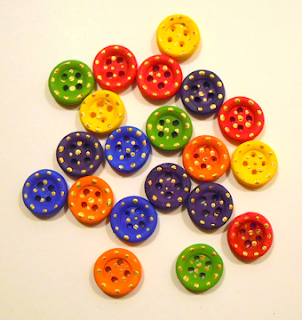I was in a dollar store yesterday and happened across a package of rather nice wooden buttons, so I thought I'd try painting them for today's elephant.
Since I've already covered the history of buttons in a previous post, I'll just describe today's activity here.
This was the package of buttons I bought—40 buttons for a mere $1.29, which I thought was a pretty good deal.
It contained four different sizes—ranging from 2.5 cm (1 inch) in diameter to 0.6 cm (1/4 inch)—with the bulk of the buttons being in the smallest size.
At first, I didn't think I wanted to paint all of them today. Then I decided to at least cover each of in a basecoat of solid colour. I chose the three primary colours and the three secondary colours, and divided the buttons more or less equally into each colour.
Because of the size of some of these, I didn't bother to draw anything with a pencil, instead just winging it. I quickly discovered that the smallest buttons were just too small to paint any kind of recognizable elephant—mostly because of the holes—so I stopped painting those.
The holes were actually a bit of an issue, because it was too easy to think of them as eyes, and hard to remember that they would ultimately be filled in with thread. There are also four holes to each button, making them fairly intrusive. Once I sew these to something, I suppose I'll see how successful I was in thinking around the holes.
Once I'd painted all but the smallest buttons with grey elephant shapes of some sort, I left them to dry.
Because these looked awfully plain to me, and because it was virtually impossible for me to add shading or outlines with any kind of finesse, I decided to add gold. I added a little gold crown to each, then a gold dot for an eye. I also added gold dots all around the rim of each button.
To make the smallest buttons match, I added a few gold dots in the central area, and dots to the rim.
This was a pretty simple activity, although it was quite time-consuming to paint the underlying colours. There is a front, back and rim to each, as well as holes to jam paint into, so it takes a while to cover the entire surface.
As for the elephant shapes, those took no time at all. The gold dots were fairly quick as well, and not even as tedious as I expected.
If I ever decide to use these on actual clothing, I'll probably have to seal them with varnish. I'm not sure I want elephant buttons on my own clothing, but they'd probably be fun on kids' clothing or a bag of some sort.
It took me a few hours to make all of these, mostly because of the underpainting, but it's not a stressful or difficult activity. I also really liked the idea of painting my own buttons, so I'm sure I'll try a variation on this again sometime.
Elephant Lore of the Day
Elephants don't like to be teased. When people extend food towards an elephant, then pull it away at the last minute, the elephant will often suffer the indignity for a short time. When the elephant has had enough, however, it will usually retaliate with tactics that range from blasting the offender with muddy water, to a good smack with tusks or trunk. Even baby elephants will readily express their displeasure, as seen in the video below of a baby elephant being teased with tasty morsels of banana.
It's an even worse idea to tease a fully grown elephant. And if an elephant suspects you of trying to steal some of its food, the consequences can be quite serious. Elephants have been known to kill people for simply borrowing a bit of hay to use as a bed, and think nothing of tossing people against a wall if unduly irritated.
In the video below, a man appears to be trying to bond with an elephant by offering it palm fronds. He also looks at one point as though he might be trying to remove one of the fronds—at least, that's how the elephant probably viewed it. If you've ever wondered how far you'd fly if an elephant were to hit you with its trunk, this video will give you a pretty good idea.
To Support Elephant Welfare
Boon Lott's Elephant Sanctuary (Thailand)
Wildlife SOS (India)
The Elephant Sanctuary (Tennessee, U.S.A.)
Fauna & Flora International
Wildlife SOS (India)
The Elephant Sanctuary (Tennessee, U.S.A.)










The wooden buttons are somewhat antique piece of art. They look stunning when attached with a woolen sweater or jersey. People do collect these items as a hobby for fun.
ReplyDeleteI know some button collectors. They have some exquisite wooden versions. :)
ReplyDelete